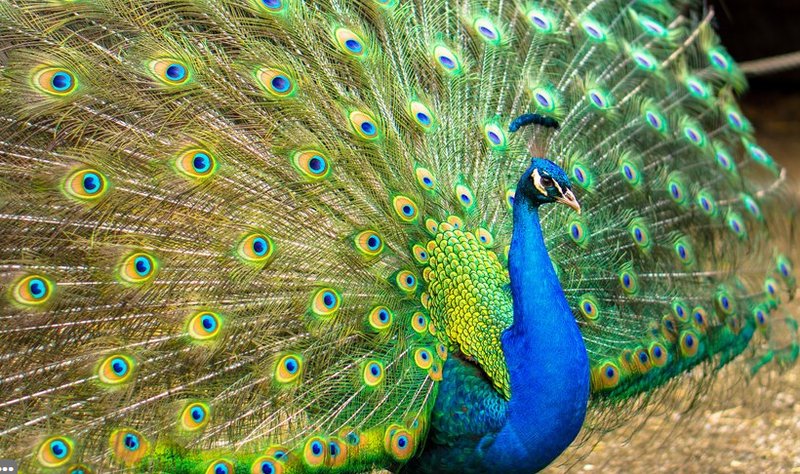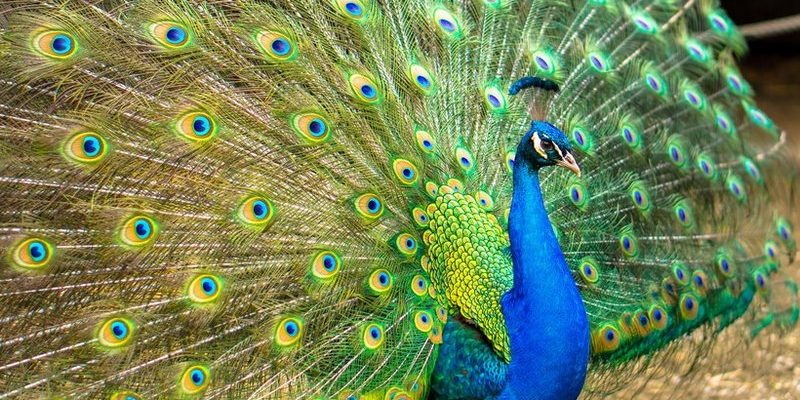
The peacock is one of nature’s most stunning creations, renowned for its vibrant colors and elaborate tail feathers. When you imagine a peacock, you might picture a dazzling display of iridescent blues, greens, and golds—but there’s much more to these birds than just their looks! Peacocks are fascinating creatures with rich histories and unique behaviors.
In many cultures, they symbolize beauty and pride, often appearing in art and mythology. However, their significance transcends mere aesthetics. Understanding peacocks gives us insight into their roles in ecosystems and their behaviors, making them a perfect subject for nature enthusiasts and curious minds alike.
What is a Peacock?
Peacocks belong to the pheasant family and are native to South Asia, although they can now be found in various parts of the world. The term “peacock” specifically refers to the males of the species, while females are called peahens, and young birds are known as peachicks. The most common species is the Indian peafowl, easily recognized by its iconic fan of feathers.
These birds are larger than they look, with males weighing up to 13 pounds and boasting tail feathers that can reach a length of over 5 feet. Their tail feathers, or trains, are adorned with eye-like patterns that can enthrall anyone who catches a glimpse.
Peacocks are omnivores, feeding on a varied diet that includes seeds, insects, small mammals, and even reptiles. Their adaptability to different food sources helps them thrive in various habitats, including forests, grasslands, and even open fields.
Physical Characteristics of Peacocks
One of the most striking features of the peacock is its plumage. Males display their colorful tail feathers during courtship rituals, fanning them out like a vibrant, shimmering umbrella. These spectacular displays serve a dual purpose: attracting potential mates and warning off rivals. The more impressive the display, the better the chances of attracting a mate.
The coloration of a peacock’s feathers is due to microscopic structures that reflect light in unique ways, creating vivid colors that seem to change depending on the angle of observation. Interestingly, peahens are less colorful, mainly brown and gray, which helps them to blend into their surroundings, especially during nesting. This camouflage is crucial for protecting themselves and their young from predators.
Another fascinating aspect of their physical makeup is their long, slender necks and strong legs, which enable them to run quickly and navigate their environments efficiently. Despite their awkward appearance when walking, peacocks can move surprisingly fast when they need to escape danger.
Habitat of Peacocks
Peacocks are primarily found in the wild in the forests and grasslands of the Indian subcontinent. They enjoy habitats that provide plenty of cover, such as dense foliage for nesting and open spaces for foraging. This combination of environments offers them the best chance to find food while remaining safe from predators.
In addition to their native habitats, peacocks are now commonly seen in parks, gardens, and animal sanctuaries around the world. They thrive well in environments where humans provide shelter, food, and care. This adaptability shows their unique ability to coexist with human populations while still maintaining their natural behaviors.
Their habitats are not just homes; they’re critical for their social structures. Peacocks are often seen in groups, known as parties, which can include several males and females. These social interactions are vital, as they help establish hierarchies that affect breeding success and survival rates.
Behavior and Social Structure
Peafowl are highly social creatures. They are known for their complex social structures, with dominance hierarchies that can influence mating opportunities. Male peacocks display their feathers in captivating courtship dances to attract peahens, often strutting and calling out to showcase their beauty. This behavior isn’t just about looks; it’s a demonstration of the male’s overall fitness and genetic quality.
Interestingly, during the day, they spend a lot of time foraging for food or basking in the sun. However, as dusk approaches, they retreat to the trees to roost at night, where they can remain safe from ground predators. Their roosting behavior is essential for safety, and they often choose trees with broad canopies to provide maximum protection.
Communication among these birds is also quite fascinating. Peacocks are known for their distinct calls and vocalizations, which vary in purpose. A male may issue loud calls to declare territory or attract females, while softer sounds are used to maintain contact within their social groups. These auditory signals play an important role in their everyday interactions.
Diet and Feeding Habits
Peacocks are omnivores, which means their diet consists of a mix of plants and animals. They typically forage on the ground, using their sharp eyesight to spot food. *Here’s the thing*: their diets can vary based on their habitat and the availability of food sources. They enjoy seeds, fruits, insects, small mammals, and even small reptiles. This wide-ranging diet is one reason they can thrive in so many environments.
During foraging, you’ll often see peacocks scratching at the ground to uncover hidden food. Their long, slender necks allow them to reach for food sources high in trees or low in the underbrush. Although they consume a variety of foods, their feeding habits can also reflect their need for specific nutrients, especially during breeding seasons.
In captivity, peacocks require a balanced diet, often supplemented with grains, pellets, and fresh vegetables. Providing proper nutrition is crucial for their health and vibrancy, particularly those stunning feathers that everyone loves to admire. Proper care ensures these birds remain healthy and continue to thrive.
Life Cycle of Peacocks
The life cycle of a peacock begins with the mating season, typically occurring in spring. Male peacocks display their impressive plumage to attract females. After mating, the peahen lays a clutch of 3 to 5 eggs, which she incubates for about 28 days. During this time, the male usually stays close by, keeping watch over the territory.
Once the eggs hatch, the peachicks are precocial, meaning they are relatively independent and can walk around and forage within a few hours. However, they stay close to their mother for warmth and protection. Young peachicks are covered in soft, downy feathers, which help them blend into their surroundings and avoid predators.
As they grow, peachicks will undergo their first molting, gradually replacing their juvenile feathers with adult plumage. This transformation takes about two to three years, during which time males develop their stunning tail feathers. It’s an exciting time, as they learn to socialize and establish their place within the peafowl hierarchy.
Conservation Status of Peacocks
While the Indian peafowl is the most well-known species and is classified as “Least Concern” by the International Union for Conservation of Nature (IUCN), habitat loss and hunting pose threats to their populations worldwide. Urbanization and agricultural expansion can lead to decreased natural habitats, making it vital to preserve the environments that support peafowl populations.
Conservation efforts are underway in several regions to protect these birds and their habitats. Organizations work tirelessly to educate the public about the importance of preserving wildlife and promoting habitats that favor peafowl. Creating protected areas and wildlife reserves is crucial for ensuring that peacocks can thrive in the future.
In some instances, peacocks are kept in captivity in zoos and wildlife parks. These facilities play a role in educating the public about their beauty and ecological importance while also working on breeding programs to maintain genetic diversity.
Interesting Facts About Peacocks
Peacocks are full of surprises! Here are a few interesting facts that might just blow your mind:
- The term “peacock” is often misused; only males are referred to as peacocks. The females are called peahens, and together they are called peafowl.
- Peacocks can fly short distances, usually up to 10 to 15 feet, despite their heavy body and long tail feathers. They often perch in trees to roost at night.
- The iridescent colors of peafowl feathers stem from microscopic structures that reflect light, rather than just pigments. This is why their colors appear to change in different lighting.
- In some cultures, peacocks are considered symbols of immortality and resurrection, often featured in art and mythology.
FAQ
What is the difference between a peacock and a peahen?
Peacocks are the males of the species, characterized by their vibrant colors and elaborate tail feathers. In contrast, peahens are the females, usually displaying more subdued colors, mainly browns and grays, which help them camouflage while nesting. This difference in coloration serves a practical purpose, aiding in their survival.
How long do peacocks live?
In the wild, peacocks can live around 15 to 20 years, but in captivity, they may live longer due to regular care and protection from predators. Proper nutrition and habitat conditions play crucial roles in their overall lifespan. Some peacocks have been known to live beyond 25 years in a controlled environment.
Are peacocks aggressive?
Peacocks can exhibit aggressive behavior, especially males during the mating season when they assert their dominance over rivals. They may puff up, fan their feathers, and hiss to establish territory. However, when not threatened or provoked, they tend to be quite docile and can often be approached without fear.
Can peacocks swim?
While peacocks are primarily terrestrial birds, they can swim if necessary. They generally prefer to avoid water, but if they find themselves in a situation where they need to escape from predators, they are capable of swimming to safety. In the wild, they might do this as a last resort.
What do peacocks eat in the wild?
In their natural habitat, peacocks have a varied diet that includes seeds, fruits, insects, and small animals. They are omnivores, meaning they will eat both plant and animal matter. This diverse diet helps them adapt to different ecological conditions and find food sources year-round.
Do peacocks mate for life?
No, peacocks do not mate for life. During the breeding season, males display to attract multiple females, called a harem. After mating, the peahens will lay eggs and raise their young independently, without continued involvement from the male. This breeding strategy allows males to increase their chances of passing on their genes.
Are peacocks found in the U.S.?
Yes, peacocks can be found in the United States, primarily in private estates, parks, and zoos. They were introduced to the country in the 1800s and have since established small populations in some areas. However, they are not considered a native species and typically require specific environments to thrive.
How can I help protect peacocks?
You can help protect peacocks by supporting conservation efforts focused on habitat preservation and education. Be mindful of wildlife when spending time in nature, and choose to support parks and wildlife organizations that promote habitat conservation. Educating others about the importance of protecting such stunning creatures also makes a significant impact.
What is the significance of peacocks in culture?
Peacocks hold different meanings across cultures. In many parts of Asia, they symbolize royalty, beauty, and pride. In India, they are considered sacred and often associated with various deities. Their striking appearance and behavior make them a popular subject in art, literature, and folklore, further cementing their status in human culture.

